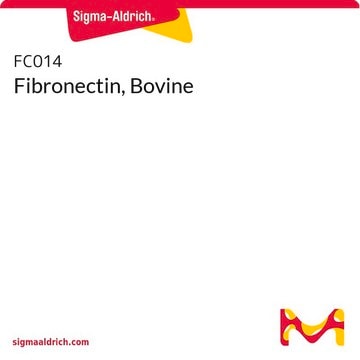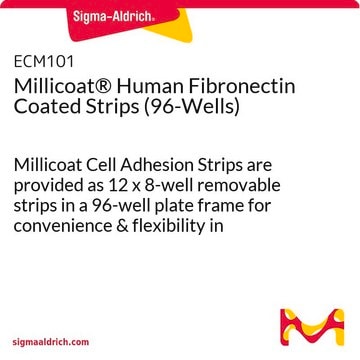F0556
Human Fibronectin
from human fibroblasts, liquid, ~0.5 mg/mL, suitable for cell culture
Synonim(y):
Fibronectin
About This Item
Polecane produkty
product name
Fibronectin solution human fibroblasts, cell culture derived, ~0.5 mg/mL, sterile-filtered, BioReagent, suitable for cell culture
pochodzenie biologiczne
human fibroblasts
Poziom jakości
sterylność
sterile-filtered
linia produktu
BioReagent
Postać
solution
masa cząsteczkowa
31 kDa
opakowanie
pkg of 100 μL
stężenie
~0.5 mg/mL
metody
cell culture | mammalian: suitable
zanieczyszczenia
HBSAG, none detected
HCV, none detected
HIV-1/HIV-2, none detected
numer dostępu NCBI
numer dostępu UniProt
Specyficzność wiązania
Peptide Source: Collagen
Warunki transportu
dry ice
temp. przechowywania
−20°C
informacje o genach
human ... FN1(2335)
Szukasz podobnych produktów? Odwiedź Przewodnik dotyczący porównywania produktów
Opis ogólny
Zastosowanie
- It is used in purification of human extracellular matrix (ECM)
- Coating of tissue culture plates with extracellular matrix components
- Used during cell culture (For xeno-free, feeder-free culture the cells were passaged in to human fibronectin along with other components)
Fibronectin from human plasma can be used with epithelial cells, mesenchymal cells, neuronal cells, fibroblasts, neural crest cells, and endothelial cells. It is recommended for use as a cell culture substratum at 1-5 μg/cm2 or 0.5-50 μg/mL. The optimal concentration does depend on cell type as well as the application and research objectives.
Działania biochem./fizjol.
Komponenty
Przestroga
Uwaga dotycząca przygotowania
Kod klasy składowania
11 - Combustible Solids
Klasa zagrożenia wodnego (WGK)
WGK 3
Temperatura zapłonu (°F)
Not applicable
Temperatura zapłonu (°C)
Not applicable
Środki ochrony indywidualnej
Eyeshields, Gloves, type N95 (US)
Certyfikaty analizy (CoA)
Poszukaj Certyfikaty analizy (CoA), wpisując numer partii/serii produktów. Numery serii i partii można znaleźć na etykiecie produktu po słowach „seria” lub „partia”.
Masz już ten produkt?
Dokumenty związane z niedawno zakupionymi produktami zostały zamieszczone w Bibliotece dokumentów.
Klienci oglądali również te produkty
Produkty
Białka macierzy zewnątrzkomórkowej, takie jak laminina, kolagen i fibronektyna, mogą być stosowane jako podłoża do mocowania komórek w hodowli komórkowej.
Extracellular matrix proteins such as laminin, collagen, and fibronectin can be used as cell attachment substrates in cell culture.
Protokoły
Dilute fibronectin for cell attachment, varying per cell type. Coating protocol, products, and FAQs provided.
Rozcieńczona fibronektyna do mocowania komórek, w zależności od typu komórek. Protokół powlekania, produkty i często zadawane pytania.
Nasz zespół naukowców ma doświadczenie we wszystkich obszarach badań, w tym w naukach przyrodniczych, materiałoznawstwie, syntezie chemicznej, chromatografii, analityce i wielu innych dziedzinach.
Skontaktuj się z zespołem ds. pomocy technicznej








